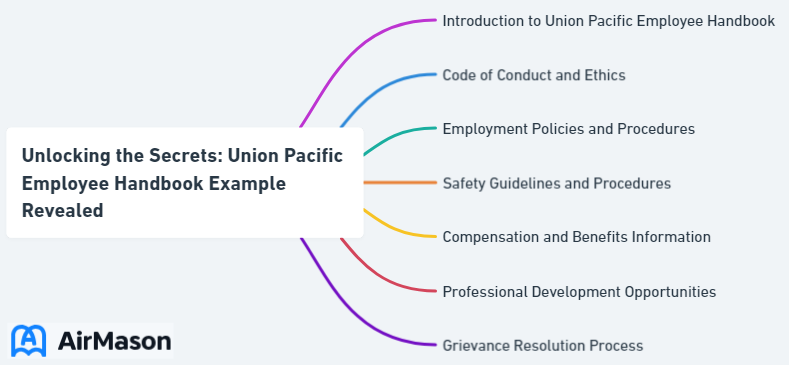
Have you ever wondered what it takes to work for one of the largest railroad companies in the United States? Union Pacific, a titan in the railway industry, sets high standards for its employees and offers a plethora of benefits. This blog post reveals the secrets of the Union Pacific Employee Handbook, providing you with an insider’s perspective on the company’s expectations, employment practices, and benefits for its workforce. We will also discuss a “union pacific employee handbook example” to give you a better understanding of the content.
By gaining a deeper understanding of Union Pacific’s employee guidelines, you’ll better grasp the values, principles, and work environment in which thousands of railway professionals thrive. Let’s uncover the mysteries of this influential organization together, starting with a union pacific employee handbook example.
Key Takeaways
- Union Pacific expects employees to prioritize safety, undergo training and comply with rules & regulations.
- The company conducts background investigations, medical requirements and adheres to equal opportunity employment policies.
- Union Pacific provides a comprehensive suite of benefits for its employees including health & wellness programs, retirement planning resources and an Employee Assistance Program (EAP).
Employee Handbook Examples
Employee handbook examples serve as valuable templates for organizations seeking to establish comprehensive guidelines for their workforce. These illustrative documents showcase the best practices in conveying company policies, employee rights, and expectations. By studying various employee handbook examples, businesses can gain insights into structuring content, addressing legal considerations, and fostering a positive workplace culture. These examples often cover a wide array of topics, including code of conduct, benefits, and procedures, offering a blueprint for creating a well-rounded and effective handbook. Whether tailoring policies to a specific industry or customizing guidelines for a unique organizational culture, exploring employee handbook examples can be instrumental in crafting a document that resonates with both management and staff.
Union Pacific’s Employee Expectations
Union Pacific, one of the major railroads in the United States, expects its employees to prioritize safety, partake in ongoing training, and comply strictly with rules and regulations. These stringent expectations ensure that the company maintains a high standard of service while safeguarding the well-being of its workforce and the smooth operation of its Union Pacific Railroad train system.
Understanding these expectations requires a detailed examination of various aspects such as:
- Safety
- Training
- Development
- Compliance with rules and regulations
These elements elucidate the operating standards employees are required to meet while working for Union Pacific.

Safety First
Safety is the top priority for all employees at Union Pacific. The company has implemented safety procedures and protocols such as:
- the use of approved chemicals only
- regular safety training programs
- a Total Safety Culture (TSC) emphasis
- reporting of equipment defects
- security awareness training
Union Pacific is committed to preventing accidents and fostering a secure work environment.
The company offers several safety training programs, including:
- Union Pacific Property Access Training Program (UP-PAT)
- Contractor safety training
- eRailSafe certification training
- Hazmat safety training
These programs ensure that employees are well-equipped to identify potential hazards and respond appropriately in the event of an accident.
Training and Development

Union Pacific recognizes the importance of investing in employee training and development to maintain a skilled and knowledgeable workforce. The corporation provides internally developed training programs, affording employees the opportunity to augment their skills and knowledge. Moreover, Union Pacific encourages employees to attend training sessions and furnishes resources and support for their development throughout their tenure.
The company offers a range of specific training programs, such as:
- The Management Development Program (MDP)
- Individual training sessions
- The Union Pacific Property Access Training Program (UP-PAT)
- The New Employee Onboarding Program
- The Operations Management Training (OMT) Program
These programs ensure that employees receive the necessary guidance and resources to excel in their roles and contribute to Union Pacific’s success.
Adherence to Rules and Regulations

Strict adherence to rules and regulations is a crucial aspect of maintaining a productive work environment at Union Pacific. Employees are required to:
- Inspect equipment and tools prior to use
- Don appropriate footwear
- Maintain high ethical standards
- Abide by laws and policies
In the event that employees contravene company rules and regulations, they may be subject to disciplinary action, including warnings, suspensions, or termination of employment. It’s essential for employees to understand the rules and regulations in place and strive to uphold these standards in their daily work activities.
Employment Practices at Union Pacific

Union Pacific’s employment practices are designed to ensure a safe, compliant, and diverse workforce. The company conducts thorough background investigations, enforces medical requirements, and is committed to equal opportunity in its hiring practices.
A comprehensive understanding of these employment practices warrants a detailed examination of background checks, medical prerequisites, and the company’s dedication to equal opportunity employment.
Macy’s Employee Handbook Example
Explore the comprehensive guidelines and policies outlined in the Macy’s employee handbook example. This invaluable resource serves as a go-to reference for Macy’s team members, offering insights into company culture, expectations, and the core values that define the Macy’s experience. From dress code to professional conduct, the Macy’s employee handbook example provides a roadmap for success within the organization. Discover the wealth of information designed to support and guide Macy’s employees throughout their journey, fostering a collaborative and thriving work environment.
Background Investigations

Background checks are an integral aspect of Union Pacific’s hiring process. These investigations serve to ensure the safety and integrity of the workforce by verifying information related to the applicant’s:
- previous employment
- educational background
- criminal record
- military service
- driving history
- credit report
- other job-related activities.
Upon extending a job offer, Union Pacific conducts background investigations for potential employees, with employment contingent upon satisfactory results. These thorough background checks are a testament to Union Pacific’s commitment to maintaining a secure and trustworthy workforce.
Medical Requirements

Union Pacific enforces medical requirements to ensure that employees are fit for duty and capable of performing their jobs safely. These requirements vary depending on the role and are determined by the company’s Health and Medical Services department.
Employees may be required to undergo medical tests and evaluations to determine their fitness for duty, as determined by Health and Medical Services. By upholding these medical requirements, Union Pacific demonstrates its dedication to maintaining a healthy and productive workforce.
Equal Opportunity Employer

Union Pacific prides itself on being an equal opportunity employer. The company strictly prohibits any discrimination or harassment based on a person’s:
- race
- color
- sex
- national origin
- age
- disability
- religion
- military and veteran status
- sexual orientation
- gender identity
- gender expression
- genetic information
- pregnancy
- any other basis prohibited by law.
By fostering an inclusive work atmosphere, Union Pacific embraces diversity, sets diversity goals, and forms employee resource groups to support its workforce. This commitment to equal opportunity ensures that all employees have a fair and equal chance to succeed and thrive within the company.
Disciplinary Action and Grievance Procedures
Disciplinary action and grievance procedures play a vital role in addressing employee concerns and maintaining a fair work environment at Union Pacific. These procedures provide a structured approach to resolving workplace conflicts and ensuring that employees are held accountable for their actions.
Examining the reasonable disciplinary action process and grievance procedures at Union Pacific, which aim to provide a balanced and fair work environment for all employees, is worthwhile.
Disciplinary Action Process
When employee misconduct or performance issues arise, Union Pacific employs a formal disciplinary action process to address these concerns. Employees enter the process at Level 0, and the level of discipline is determined through the Discipline Assessment Table.
The company takes disciplinary measures, which can range from verbal warnings to termination of employment, depending on the severity of the misconduct. By adhering to this structured process, Union Pacific ensures fair and consistent treatment of all employees, while promoting a professional and accountable work environment.
Grievance Procedures

Grievance procedures provide employees with a means to voice their concerns and seek resolution for workplace issues. Union Pacific manages employee grievances through a formal grievance procedure, the details of which can be found in the Union Pacific Employee Handbook.
These grievance procedures allow employees to report incidents to the Equal Employment Opportunity Department or their supervisor. By providing a transparent and structured process for resolving grievances, Union Pacific demonstrates its commitment to maintaining a fair and harmonious work environment.
Labor Relations at Union Pacific
Labor relations at Union Pacific involve working closely with labor unions to ensure the rights and interests of employees are protected. Union representation and collective bargaining agreements are essential components of the company’s labor relations strategy.
A detailed examination of union representation and the role of collective bargaining agreements in shaping the work experience for unionized employees will provide a comprehensive understanding of labor relations at Union Pacific.
C.H. Robinson Worldwide Employee Handbook Example
Exploring the C.H. Robinson Worldwide employee handbook example provides valuable insights into the company’s culture, policies, and guidelines. Within the C.H. Robinson Worldwide employee handbook example, employees can find comprehensive information about their rights, responsibilities, and the organization’s commitment to fostering a positive work environment. This handbook exemplifies the company’s dedication to transparency and clear communication, offering a reliable resource for employees to navigate various aspects of their professional journey at C.H. Robinson Worldwide.
Union Representation
Union representation serves as a vital support system for employees at Union Pacific. The company collaborates with 14 major rail unions, which represent approximately 85 percent of the company’s full-time employees. National labor agreements are established between Union Pacific and the unions to regulate matters such as working conditions, wages, and benefits.
Unions provide employees with:
- A platform to express their interests
- Negotiation power with management
- Advocacy for improved wages and working conditions
- A collective voice and involvement in decision-making processes
By offering these benefits, unions play a crucial role in enhancing the work experience for Union Pacific employees.
Collective Bargaining Agreements
Collective bargaining agreements are negotiated contracts between Union Pacific and labor unions that outline the terms and conditions of employment for unionized employees. These agreements cover aspects such as:
- Wages and compensation
- Benefits
- Working conditions and safety measures
- Grievance procedures
- Rights and protections for employees
These agreements are reached through negotiations between the company and the unions and serve to govern the relationship between Union Pacific and its employees. By adhering to collective bargaining agreements, Union Pacific ensures a fair and consistent work environment for its unionized workforce.
Benefits and Perks for Union Pacific Employees
Union Pacific offers a range of benefits and perks for its employees, designed to support their well-being and provide a competitive compensation package. From health and wellness programs to retirement planning and employee assistance, the company strives to create an attractive and supportive work environment for its workforce.
Examining the various benefits and perks available to Union Pacific employees will shed light on factors contributing to a positive and rewarding work experience.
Health and Wellness
Union Pacific recognizes the importance of promoting health and wellness among its employees. The company offers a wellness program titled “Take Charge. Feel Better. Live More.” which provides resources to address both mental and physical health needs of employees. In addition, they offer an Employee Assistance Program (EAP) that provides counseling and referral services for employees and their families.
These programs demonstrate Union Pacific’s commitment to supporting the well-being of its employees and creating a healthy work environment where employees can thrive.
Retirement and Financial Planning
Retirement and financial planning resources are essential in helping employees prepare for their future and achieve financial security. Union Pacific offers retirement plans through the Railroad Retirement Board (RRB) and the UP Pension Plan for its employees. The company also provides financial planning services, tax planning services, and investment management services to assist employees in achieving a successful retirement.
By offering comprehensive retirement and financial planning resources, Union Pacific demonstrates its commitment to the long-term financial well-being of its employees.
Employee Assistance Programs
Employee assistance programs at Union Pacific provide support for employees facing personal or work-related challenges. The Employee Assistance Program (EAP) offers 24/7 confidential support, counseling, and referral services to employees and their families who are facing personal challenges.
These programs are designed to help employees manage personal and emotional issues, ensuring they have the necessary support to maintain their well-being and perform effectively in their roles.
Summary
In conclusion, the Union Pacific Employee Handbook reveals the company’s high expectations, commitment to employee development, and dedication to maintaining a fair and supportive work environment. By prioritizing safety, training, and adherence to rules and regulations, Union Pacific ensures a secure and productive workplace for its valued employees.
As we’ve uncovered the secrets of the Union Pacific Employee Handbook, it’s clear that the company goes the extra mile to provide a rewarding work experience for its employees. With an array of benefits, perks, and support systems in place, Union Pacific continues to stand out as a desirable employer in the railway industry.
Frequently Asked Questions
Does Union Pacific have a nepotism policy?
Union Pacific has a Nepotism Policy in place that outlines their stance on hiring based on merit and job-related qualifications.
What is the PTO policy for Union Pacific Railroad?
Union Pacific Railroad’s PTO and Vacation policy offers 20-30 days off annually, with 33% of employees expected to work while out of office.
What is the Union Pacific attendance policy 2023?
Union Pacific’s attendance policy effective from January 15, 2023 forwards will involve employees monitoring their own attendance based on a points-based system; exceeding 28 points may result in a violation under this policy.
What are the benefits of working for Union Pacific?
Working at Union Pacific comes with numerous benefits, such as tuition reimbursement, vision insurance, vacation and holiday pay, medical and retirement benefits, and an Educational Assistance Program to promote skill growth. Employees rate these perks highly, providing a positive work environment for all staff.
What safety training programs does Union Pacific provide to its employees?
Union Pacific provides safety training programs like UP-PAT, contractor safety training, eRailSafe certification training, and Hazmat safety training, helping ensure their employees’ safety.
Important Disclaimer:
The article presented here does not serve as a representation of the company’s actual employee handbook mentioned in this article.
Our discussions and insights regarding employee handbook are based on assumptions about what may be considered significant in this companies’ policies. These assumptions are drawn from available information and industry knowledge. Readers are advised that the content provided is for informational purposes only and should not be construed as an exact reflection of any company’s official policies or procedures. For precise and accurate details regarding a company’s employee handbook, individuals should refer directly to the company’s official documentation or consult with appropriate representatives.
Please be aware that the content on this page has been generated by using artificial intelligence language models and may contain errors, inconsistencies, or outdated information. It is provided as-is without any warranties or guarantees of accuracy. We strongly recommend using this content as a starting point for further research. We disclaim any liability for damages or losses resulting from the use or reliance on this content.